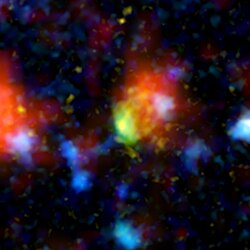| Baby Boom Galaxy | |
|---|---|
 Baby Boom Galaxy (Green-Red Splotch) | |
| Observation data (J2000 epoch) | |
| Constellation | Sextans |
| Right ascension | 10h 00m 54.52s [1] |
| Declination | +02° 34′ 35.2″ [2] |
| Redshift | 280919 km/s [2] |
| Distance | 12,477 million light years (light travel distance) 25,080 million light years (present proper distance) |
| Characteristics | |
| Type | Starburst galaxy, [1] SMG [3] |
| Other designations | |
| COSMOS 2328516, [2] Baby Boom Galaxy | |
The Baby Boom Galaxy is a starburst galaxy located about 12.477 billion light years away (co-moving distance is 25.08 billion light years). [1] [4] Discovered by NASA's Spitzer Science Center at the California Institute of Technology, the galaxy is the record holder for the brightest starburst galaxy in the very distant universe, with brightness being a measure of its extreme star-formation rate. [5] The Baby Boom Galaxy has been nicknamed "the extreme stellar machine" because it is seen producing stars at a rate of up to 4,000 per year (almost 11 stars per day). The Milky Way galaxy in which Earth resides turns out an average of just 10 stars per year. [4]